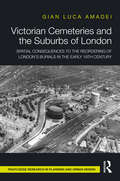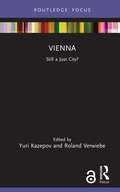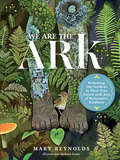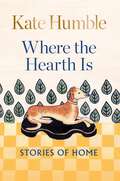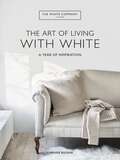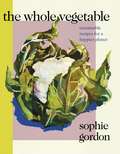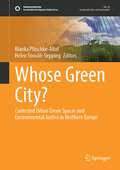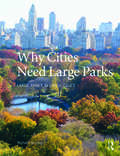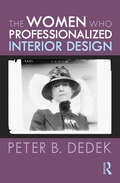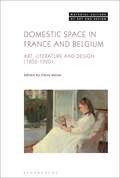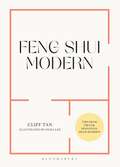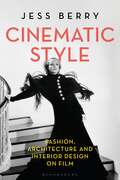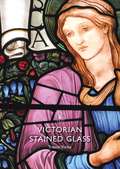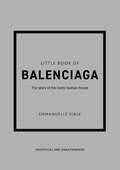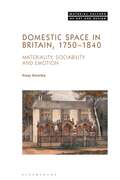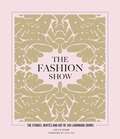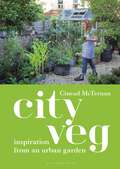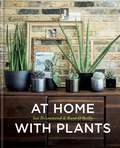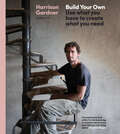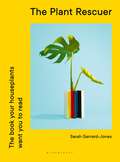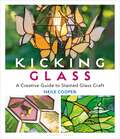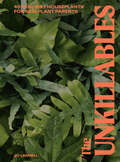- Table View
- List View
Victorian Cemeteries and the Suburbs of London: Spatial Consequences to the Reordering of London’s Burials in the Early 19th Century
by Gian Luca AmadeiThis book explores how Victorian cemeteries were the direct result of the socio-cultural, economic and political context of the city, and were part of a unique transformation process that emerged in London at the time. The book shows how the re-ordering of the city’s burial spaces, along with the principles of health and hygiene, were directly associated with liberal capital investments, which had consequences in the spatial arrangement of London. Victorian cemeteries, in particular, were not only a solution for overcrowded graveyards, they also acted as urban generators in the formation London’s suburbs in the nineteenth century. Beginning with an analysis of the conditions that triggered the introduction of the early Victorian cemeteries in London, this book investigates their spatial arrangement, aesthetics and functions. These developments are illustrated through the study of three private Victorian burial sites: Kensal Green Cemetery, Highgate Cemetery and Brookwood Cemetery. The book is aimed at students and researchers of London history, planning and environment, and Victorian and death culture studies.
Victorian Cemeteries and the Suburbs of London: Spatial Consequences to the Reordering of London’s Burials in the Early 19th Century
by Gian Luca AmadeiThis book explores how Victorian cemeteries were the direct result of the socio-cultural, economic and political context of the city, and were part of a unique transformation process that emerged in London at the time. The book shows how the re-ordering of the city’s burial spaces, along with the principles of health and hygiene, were directly associated with liberal capital investments, which had consequences in the spatial arrangement of London. Victorian cemeteries, in particular, were not only a solution for overcrowded graveyards, they also acted as urban generators in the formation London’s suburbs in the nineteenth century. Beginning with an analysis of the conditions that triggered the introduction of the early Victorian cemeteries in London, this book investigates their spatial arrangement, aesthetics and functions. These developments are illustrated through the study of three private Victorian burial sites: Kensal Green Cemetery, Highgate Cemetery and Brookwood Cemetery. The book is aimed at students and researchers of London history, planning and environment, and Victorian and death culture studies.
Vienna: Still a Just City? (Built Environment City Studies)
by Yuri Kazepov Roland VerwiebeThis book explores and debates the urban transformations that have taken place in Vienna over the past 30 years and their consequences in policy fields such as labour and housing, political and social participation and the environment. Historically, European cities have been characterised by a strong association between social cohesion, quality of life, economic ambition and a robust State. Vienna is an excellent example for that. In more recent years, however, cities were pressured to change policy principles and mechanisms in the context of demographic shifts, post-industrial transformations and welfare recalibration which have led to worsened social conditions in many cities. Each chapter in this volume discusses Vienna’s responses to these pressures in key policy arenas, looking at outcomes from the context-specific local arrangements. Against a theoretical framework debating the European city as a model of inclusion and social justice, authors explore the local capacity to innovate urban policies and to address new social risks, while paying attention to potential trade-offs. The book questions and assesses the city’s resilience using time series and an institutional analysis of four key dimensions that characterise the European city model within the context of post-industrial transition: redistribution, recognition, representation and sustainability. It offers a multiscalar perspective of urban governance through labour, housing, participatory and environmental policies, bringing together different levels and public policy types. Vienna: Still a Just City? is aimed at academics, researchers and policy-makers in urban studies, including urban sociology, ecology, geography and welfare.
Vienna: Still a Just City? (Built Environment City Studies)
by Yuri KazepovThis book explores and debates the urban transformations that have taken place in Vienna over the past 30 years and their consequences in policy fields such as labour and housing, political and social participation and the environment. Historically, European cities have been characterised by a strong association between social cohesion, quality of life, economic ambition and a robust State. Vienna is an excellent example for that. In more recent years, however, cities were pressured to change policy principles and mechanisms in the context of demographic shifts, post-industrial transformations and welfare recalibration which have led to worsened social conditions in many cities. Each chapter in this volume discusses Vienna’s responses to these pressures in key policy arenas, looking at outcomes from the context-specific local arrangements. Against a theoretical framework debating the European city as a model of inclusion and social justice, authors explore the local capacity to innovate urban policies and to address new social risks, while paying attention to potential trade-offs. The book questions and assesses the city’s resilience using time series and an institutional analysis of four key dimensions that characterise the European city model within the context of post-industrial transition: redistribution, recognition, representation and sustainability. It offers a multiscalar perspective of urban governance through labour, housing, participatory and environmental policies, bringing together different levels and public policy types. Vienna: Still a Just City? is aimed at academics, researchers and policy-makers in urban studies, including urban sociology, ecology, geography and welfare.
We Are the ARK: Returning Our Gardens to Their True Nature Through Acts of Restorative Kindness
by Mary Reynolds&“Reynolds gives us a much-needed reason for hope. The gardener, the conservationist, the city planner, and the nature lover will all be inspired for this wonderful book shows how thousands of even small wildlife friendly gardens can provide habitat for embattled wildlife around the world.&” —Jane Goodall, Phd, DBE, Founder of the Jane Goodall Institute & UN Messenger of Peace Individuals can&’t save the world alone. But if millions of us work together to save our own patch of earth—then we really have a shot. How do we do it? With Acts of Restorative Kindness (ARK). An ARK is a restored, native ecosystem. It&’s a thriving patch of native plants and creatures that have been allowed and supported to re-establish in the earth's intelligent, successional process of natural restoration. Over time, this becomes a pantry and a habitat for our pollinators and wild creatures who are in desperate need of support. These ARKs will become the seeding grounds for our planet&’s new story. They will be sanctuaries for our shared kin—the rooted and unrooted—and safe havens for the magic and abundance of the natural world. Most importantly, the ARK-building actions are within our control and laid out here in We Are the ARK. In these inspiring pages, discover how one person&’s actions can effect big change in this world. Even the tiniest postage stamp patch of land matters! Together we are building a patchwork quilt of life that will wrap its way around this planet.
Where the Hearth Is: Stories of home (Kate Humble)
by Kate HumbleKate Humble has a knack for sharing her own journey towards a more pleasing and purposeful life in a way that inspires readers, enables them to reassess their own lives and helps them achieve their personal goals. Having encouraged readers to reconnect with nature in Thinking on My Feet and simplify their lifestyles in A Year of Living Simply, she turns now to reimagining whatever we consider 'home' - examining her own experiences and expectations, ideals and memories, and considering the views of others living uniquely, extraordinarily, happily. She's gaining insights from some unexpected quarters - including the animal kingdom.As our time spent in office buildings and other traditional workplaces shrinks forevermore, feeling happy, healthy, productive and content in our homes (be they castles or caravans, flat-shares or farms, fixed or temporary, inner city/out of town/beyond) is more important to get right than ever before. Where the Hearth Is will resonate with all those seeking to make the most of their lives during the many hours we all spend at home - whether it's a case of tiny adjustments while staying put, moving out, living differently or dreaming of building something new.
The White Company The Art of Living with White: A Year of Inspiration (White Company)
by Chrissie Rucker CompanyFrom the author of the home decorating bestseller, For the Love of White, comes an inspirational and informative guide to creating a welcoming home through the seasons using a white and neutral palette.'I love a home to feel warm, inviting, personal and lived-in - and mastering how to decorate with white and neutrals is a wonderful way to achieve this.' - CHRISSIE RUCKERIn her much-anticipated second book, The Art Of Living With White, Chrissie Rucker, Founder of The White Company, explores 10 inspirational homes that illustrate beautifully different ways to use white and neutrals through the seasons. The homes vary in size, style and location - from a minimalist city pied-à-terre to a New England-style country house - but what unites them all is the welcoming, stylish and calm feel that their owners have each created.The homes are grouped into the four seasons and each chapter ends with a summary of seasonal rituals that will work in any home. A concluding chapter - Inspiration & Resources - considers finding your own style, how to create a good balance between work and home in interior spaces, the art of simple entertaining and the importance of scent and touch in a truly comfortable home.Praise for The White Company: For the Love of White'A testament to the power of neutrals' - House and Garden'A visual feast with a passion for all things white at its heart' - House Beautiful
The Whole Vegetable
by Sophie GordonDiscover wholesome, sustainable and plant-based dishes in this essential cookbook for everyone from full-time vegans to those who just want to do their bit for the environment'Hearty, healthy, flavour-packed dishes' MAIL ON SUNDAY'A uniquely sustainable and delicious approach to modern plant-based cooking' VOGUE_________Have you ever wondered how to make your diet truly eco-conscious?In this beautiful plant-based cookbook, over 130 creative, delicious, planet-friendly recipes put vegetables at the very centre of the table. Embracing often-discarded parts such as leaves, stalks, tops, flowers, seeds and even peelings, this is cooking at its most sustainable.In The Whole Vegetable, Sophie Gordon shows us how to:- Cook with every part of every vegetable- Reduce waste in your cooking- Reinvent your leftovers- Eat with the seasonsFrom Cauliflower Carbonara, Broccoli Pesto and Chunky Pumpkin Tacos, to Cherry Breakfast Crumble, Maple-Roasted Pears and Apple & Walnut Danish Buns, The Whole Vegetable is packed with thoughtful recipes for every season.Most of all, it will ensure that nothing in your kitchen goes to waste._________'Creative, delicious, planet-friendly recipes . . . Teaches you how to put those often discarded parts of fruit and veg to good (and tasty) use' Women's Health'The Whole Vegetable heroes plant-based cookery, with recipes that also help reduce food waste in the kitchen and improve sustainable living. A worthwhile read' Good Housekeeping
Whose Green City?: Contested Urban Green Spaces and Environmental Justice in Northern Europe (Sustainable Development Goals Series)
by Bianka Plüschke-Altof Helen Sooväli-SeppingAgainst the backdrop of an accelerating global urbanization and related ecological, climatic or social challenges to urban sustainability, this book focuses on the access to “safe, inclusive and accessible green and public space” as outlined in United Nations’ Sustainable Development Goal No. 11. Looking through the lens of environmental justice and contested urban spaces, it raises the question who ultimately benefits from a green city development, and – even more importantly – who does not. While green space benefits are well-documented, green space provision is faced by multiple challenges in an era of urban neoliberalism. With their interdisciplinary and multi-method approach, the chapters in this book carefully study the different dimensions of green space access with particular focus on vulnerable groups, critically evaluate cases of procedural injustice and, in the case of Northern Europe that is often seen as forerunner of urban sustainability, provide in-depth studies on the contexts of injustices in urban greening. Chapters 1, 5, and 6 are available open access under a Creative Commons Attribution 4.0 International License via link.springer.com.
Why Cities Need Large Parks: Large Parks in Large Cities
by Richard MurrayThe large parks and green infrastructure presented here illustrate the diverse uses and many benefits of large urban parks across 30 major cities. Demand for large urban parks emerged at the height of the First Industrial Revolution in the mid-1800s, when large urban parks represented new ideas of accessible public spaces, often established on land previously owned by aristocracy, royalty or the army. They represented new ideas on how city life could be improved and how large green spaces could enhance urban citizens’ physical and psychological well-being (e.g. Birkenhead Park in Liverpool, Bois de Boulogne in Paris, Tiergarten in Berlin and Central Park in New York City). Today, large urban parks are habitats for biodiversity and spaces of climate change adaptation. For people living in cities, this biodiversity may represent high cultural, recreational and aesthetic values, but is also important for other aspects of health and well-being, for example by reducing the urban heat island effect, air pollution and risks of flooding. At a time when we are seriously reconsidering how we live in cities and our urban quality of life, while also grappling with serious challenges of climate change, the authors of this book detail the much-needed evidence, pathways and vision for a future of more liveable, resilient cities where large urban parks are at the core. This book will help park managers, NGOs, landscape architects and city planners to develop the green city of the future.
The Women Who Professionalized Interior Design
by Peter DedekThe Women Who Professionalized Interior Design explores the history of interior decorating and design from the late nineteenth century to the present, highlighting the careers and contributions of significant American female interior designers who were instrumental in the creation of the field of residential and commercial interior design in the United States. This book explores how interior design emerged as a distinct, paying occupation in the nineteenth century thanks to a growing middle class and an increase in available cheap household goods following the Industrial Revolution. Focusing primarily on the period from 1905 to 1960, it addresses the complex relationships among professionals in the design fields, the social dynamics of designer-client relationships, and how class, culture, and family influenced their lives and careers. The book emphasizes significant female interior decorators and writers on design including Candace Wheeler, Elsie de Wolfe, Edith Wharton, Nancy McClelland, Ruby Ross Wood, Dorothy Draper, Eleanor McMillen Brown, and Sister Parish, all of whom are underrepresented in the historical record, relating their stories within the context of the history of design and architecture. This book is an ideal and concise resource for students and faculty of interior design and women’s history.
The Women Who Professionalized Interior Design
by Peter DedekThe Women Who Professionalized Interior Design explores the history of interior decorating and design from the late nineteenth century to the present, highlighting the careers and contributions of significant American female interior designers who were instrumental in the creation of the field of residential and commercial interior design in the United States. This book explores how interior design emerged as a distinct, paying occupation in the nineteenth century thanks to a growing middle class and an increase in available cheap household goods following the Industrial Revolution. Focusing primarily on the period from 1905 to 1960, it addresses the complex relationships among professionals in the design fields, the social dynamics of designer-client relationships, and how class, culture, and family influenced their lives and careers. The book emphasizes significant female interior decorators and writers on design including Candace Wheeler, Elsie de Wolfe, Edith Wharton, Nancy McClelland, Ruby Ross Wood, Dorothy Draper, Eleanor McMillen Brown, and Sister Parish, all of whom are underrepresented in the historical record, relating their stories within the context of the history of design and architecture. This book is an ideal and concise resource for students and faculty of interior design and women’s history.
Domestic Space in France and Belgium: Art, Literature and Design, 1850-1920 (Material Culture of Art and Design)
Domestic Space in France and Belgium offers a new addition to the growing body of work in Interior Studies. Focused on late 19th and early 20th-century France and Belgium, it addresses an overlooked area of modernity: the domestic sphere and its conception and representation in art, literature and material culture. Scholars from the US, UK, France, Italy, Canada and Belgium offer fresh and exciting interpretations of artworks, texts and modern homes. Comparative and interdisciplinary, it shows through a series of case-studies in literature, art and architecture, how modernity was expressed through domestic life at the turn of the century in France and Belgium.
Feng Shui Modern
by Cliff TanThe ancient practice of feng shui is uncovered in this simple and practical guide, revealing the tools that will lead to a healthier, happier home for every budget.How do you place a bed in an awkward room? How can your space help you be more focused and more productive? How do you set up your room to make you ready for romantic love? It's simple!In Feng Shui for Modern Living, TikTok influencer Cliff Tan answers these questions and more, explaining the ancient practice of feng shui and how it can be translated to modern homes. Cliff has become an internet sensation with his videos demonstrating the principles of feng shui, and in this practical guide he shows how to apply these principles room-by-room in your own home. He takes you behind the mysticism to reveal the logic behind feng shui. This is the key to unlocking the power of this ancient practice: once you understand the logic, your application of feng shui will work every time. There is no room too challenging, no problem that feng shui can't unravel. That's why people have been using it for thousands of years. In the tradition of Marie Kondo and Mrs Hinch, this guide will revolutionise how you think about your space. It's feng shui made simple, and anyone can learn.
Cinematic Style: Fashion, Architecture and Interior Design on Film
by Jess BerryFrom cinema's silent beginnings, fashion and interior design have been vital to character development and narrative structure. Despite spectacular technological advancements on screen, stunning silhouettes and striking spaces still have the ability to dazzle to dramatic effect. This book is the first to consider the significant interplay between fashion and interiors and their combined contribution to cinematic style from early film to the digital age.With examples from Frank Lloyd Wright inspired architecture in Hitchcock's North by Northwest, to Coco Chanel's costumes for Gloria Swanson and a Great Gatsby film-set turned Ralph Lauren flagship, Cinematic Style describes the reciprocal relationship between these cultural forms. Exposing the bleeding lines between fashion and interiors in cinematic and real-life contexts, Berry presents case studies of cinematic styles adopted as brand identities and design movements promoted through filmic fantasy.Shedding light on consumer culture, social history and gender politics as well as on fashion, film and interior design theory, Cinematic Style considers the leading roles domestic spaces, quaint cafes, little black dresses and sharp suits have played in 20th and 21st-century film.
Victorian Stained Glass (Shire Library)
by Trevor YorkeA beautifully illustrated guide to the world of Victorian stained glass and its manufacturers and designers.Victorian stained glass – magnificent, colourful and artistic – adorns countless British churches, municipal buildings and homes. Across the decades, several artistic movements influenced these designs, from the Gothic Revival, through the Arts and Crafts Movement and into Art Nouveau as a new century dawned. Historian Trevor Yorke shows how craftsmen re-learned the lost medieval art of colouring, painting and assembling stained glass windows – but also, in this age of industry, how windows were templated and mass produced. Showcasing the exquisite glass generated by famous designers such as A.W.N. Pugin, Pre-Raphaelites William Morris and Edward Burne-Jones, and by leading manufacturers such as Clayton and Bell, this beautifully illustrated book introduces the reader to many wonderful examples of Victorian stained glass and where it can be found.
The Little Book of Balenciaga: The Story of the Iconic Fashion House (Little Book Of Fashion Ser.)
by Emmanuelle Dirix'Haute couture is like an orchestra, whose conductor is Balenciaga. We other couturiers are the musicians and we follow the direction he gives' - Christian DiorThe godfather of conceptual design, a master of shape, a true fashion game changer – all are accolades bestowed upon one of the most interesting, venerated and iconic couturiers of the twentieth century: Cristóbal Balenciaga. His pureness of line, the comfort of his garments and innovative work with textiles, colour and volume made a huge impact on twentieth-century fashion, with creations such as the babydoll, balloon and sack dresses still influencing fashion today.Through stunning images and captivating text, Little Book of Balenciaga depicts the work and life of Balenciaga the couturier. Fashion historian Emmanuelle Dirix examines his legacy both through tracing the Maison's artistic direction after his death, and the generations of designers influenced by the master himself.
Domestic Space in Britain, 1750-1840: Materiality, Sociability and Emotion (Material Culture of Art and Design)
by Freya GowrleyBetween 1750 and 1840, the home took on unprecedented social and emotional significance. Focusing on the design, decoration, and reception of a range of elite and middling class homes from this period, Domestic Space in Britain, 1750-1840 demonstrates that the material culture of domestic life was central to how this function of the home was experienced, expressed, and understood at this time. Examining craft production and collection, gift exchange and written description, inheritance and loss, it carefully unpacks the material processes that made the home a focus for contemporaries' social and emotional lives.The first book on its subject, Domestic Space in Britain, 1750-1840 employs methodologies from both art history and material culture studies to examine previously unpublished interiors, spaces, texts, images, and objects. Utilising extensive archival research; visual, material, and textual analysis; and histories of emotion, sociability, and materiality, it sheds light on the decoration and reception of a broad array of domestic spaces. In so doing, it writes a new history of late eighteenth- and early nineteenth-century domestic space, establishing the materiality of the home as a crucial site for identity formation, social interaction, and emotional expression.
The Fashion Show: The stories, invites and art of 300 landmark shows
by Iain R WebbThis is your invitation to the front row. Spanning over seven decades and 300 shows, this beautiful book tells the story of the high fashion catwalk. Through this inspirational collection of fashion show invites and tales from fashion week, curator and fashion writer Iain R Webb opens a window into the world's most exclusive fashion houses.Whether it's dreamy romance at Givenchy, cutting-edge modernity at Alexander McQueen, floral drama at Valentino, vintage-inspired fun at Kenzo or heartfelt emotion at Yves Saint Laurent's final haute couture show, the unique themes and styles that have graced the runway in the past 50 years are gloriously curated and described in The Fashion Show.From understated presentation to melodramatic performance, this stylish archive is your passport to the international fashion collections.
City Veg: Inspiration from an Urban Garden
by Cinead McTernanGrowing your own vegetables is good for your health, the environment and even your wallet! And eating a plant-based diet – whether you're a vegan, vegetarian or are just trying to eat more greens – is gaining popularity as a sensible, healthy solution to combat obesity and as a way of caring for the planet. More and more of us are looking to grow some of our own fruit and vegetables and be more mindful by choosing seasonal ingredients. Written over a year, City Veg is the candid account of an urban grower from her own productive city plot, with all the triumphs and minor woes that go hand-in-hand with a small, suburban location. From planning and designing her garden in January to harvesting and using her home-grown produce throughout the growing season and right up until December, City Veg takes readers on a personal journey that will entertain experienced growers while sharing plenty of practical information to help newbie growers get off to a great start. Packed with growing advice, monthly harvesting guides, tips and simple projects, and quick and easy recipe ideas to accompany growing themes.
At Home with Plants
by Ian Drummond Kara O'Reilly***A stylish addition to the current craze for indoor greenery, this is as much about how you use plants as an integral part of contemporary decor as how to keep them alive and well. - The Sunday TimesHouseplants are hot, and creative interior planting is becoming increasingly easy to achieve. The new wave of unusual and dramatic indoor plants is as much about décor and statement as greenery. Used aesthetically, as a focal point and sculptural element in interior design, indoor gardening is not just about possessing or growing a plant, but about using it as an accessory combined with other objects to create a particular style and mood. In this much-needed book, now reissued with a new cover and updated source directory, Ian and Kara show you how to transform your home with plants and tells you which plants will work best where and how to care for them. From strikingly geometric terrariums to pretty hanging baskets, practical herb pots and colourful window displays, this book is packed full of exciting and gorgeous ideas. Specially commissioned photography by Nick Pope throughout proves that bringing the outdoors in really is the best form of interior design.
Build Your Own: Use What You Have to Create What You Need
by Harrison GardnerMaking, maintaining and mending our own homes is part of what makes us human. It is a skill that was alive and well until just a few generations ago. Harrison Gardner is a man on a mission to help us rediscover the lost art of building our own home while treading more lightly on the planet in the process.Build Your Own explores the principles of construction and outlines a multitude of practices and methods that enable you to build a home with the materials available to you. Techniques such as bricklaying, plastering, flooring, making mortar and building walls are distilled into simple, practical recipes anyone can try themselves.Whether you plan to build your own structure, are curious about the idea or are working with professionals, Build Your Own is an essential tool that shows that anyone can learn to build – and perhaps everyone should.
The Plant Rescuer: The book your houseplants want you to read
by Sarah Gerrard-JonesA simple, stylish and complete guide for any houseplant ownerWhether you have just one or many houseplants, this is the book they need you to read. It is a clear and practical toolkit on all aspects of plant care from how to choose a plant to tips for everyday care. Changes in your plant's appearance are often a cry for help and this book will help you understand their needs. Learn how to help your plants not only survive but thrive. Sarah, also known as @theplantrescuer, is a self-taught houseplant obsessive who firmly believes every plant deserves a happy life. Her determination to see beyond the 'perfect plant' and to rescue unloved plants makes her the go-to guide.
Kicking Glass: A Creative Guide to Stained Glass Craft
by Neile CooperCreative and practical, Kicking Glass is a step-by-step guide for those wanting to practice the popular craft of stained glass. From simple suncatchers and boho lamps to exquisite 3D constructions and delicately-poised glass butterflies, experienced artist Neile Cooper guides you through the magical world of stained glass with a creative handbook for both the novice and more experienced crafter alike. Beautifully illustrated with photographs of Neile's own work including her glorious glass cabin in the woods as well as pieces from some of today's most stylish designers, Kicking Glass is packed with ideas to guide and inspire. This book provides comprehensive technical instruction in the copper foil method, covering everything from tools and supplies to exploratory techniques such as including foraged and found objects into your work. Skills are demonstrated through tutorials with photos, instructional drawings and 16 stunning patterns. Whether you're looking to decorate your windows, create lovely gifts for friends and family or design your own epic masterpiece, Kicking Glass is the essential modern guide to stained glass making.
The Unkillables: 40 resilient house plants for new plant parents
by Jo LambellFeaturing over 40 cool, high-maintenance-looking plants, The Unkillables will ensure your put your plant-murdering days firmly in the past, and will transform your home into the gorgeous green space you always dreamed of. Are you a plant killer? There's nothing more heart-breaking than bringing your new plant baby home, only to have it die a slow death in front of your very eyes. Was it too much water? Not enough sunlight? A drafty corner? The reasons for planticide can seem endless!In The Unkillables, Jo Lambell shares her houseplant knowledge so that even the biggest plant serial killers can have an abundant indoor garden. Jo will take the fear out of the unknown and equip those with no green fingers at all with the skills they need to keep their plants alive and thriving. Plants can be a little intimidating – with their fancy Latin names, complex terminology and 'just look at me and I'll perish' reputation – so choosing hardy, tolerant plants is the best place to start. Jo walks you through the basics of care – light, water, location – as well as sharing information on repotting, propagating, cleaning, First Aid and more.
